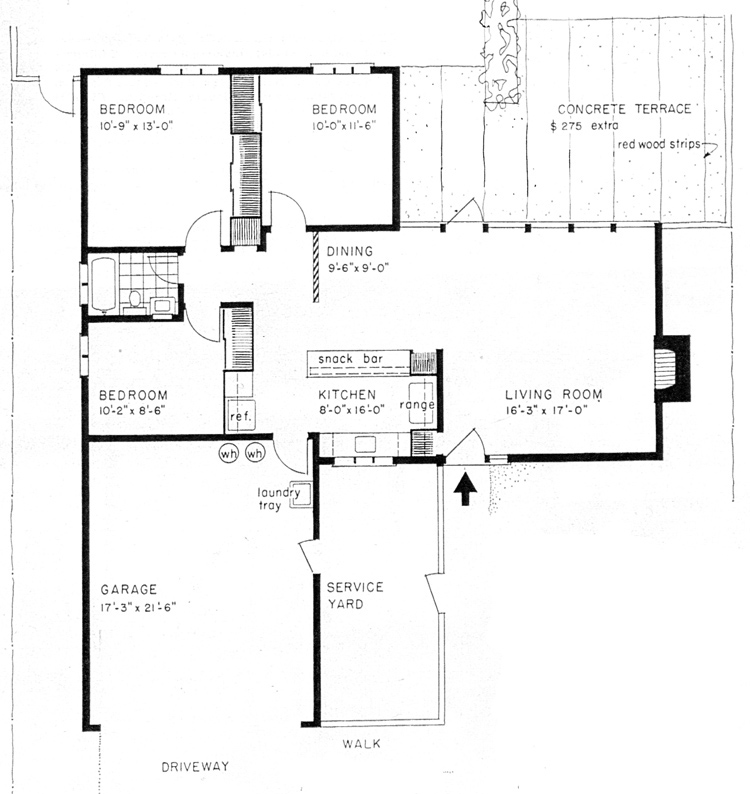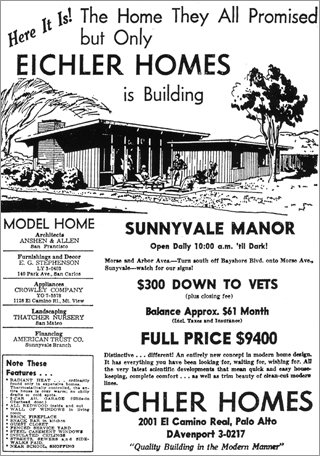What's Become of the Holy Grail? - Page 2
Those kitchen windows appear to violate the Anshen and Allen's pledge to present what Anshen called "a blank wall to the street?" Originally, the windows opened not onto the street but onto a fenced 'service yard,' where moms could hang laundry or peel onions.
Only two homes in the neighborhood still have service yards. In most of the homes, the fences that created the yard are long gone. In other cases, the yard has been incorporated into the house itself.
 |
|
|
The Caturas' home does retain its enclosed courtyard. And though, like most homes in the neighborhood, it has lost other character-defining features, including the interior redwood paneling and hanging kitchen cabinets, it remains a striking and attractive home. It has a wall of glass to the backyard, a brick fireplace with built-in brick shelves for doodads, a handy little pantry alongside the kitchen, and a Japanese garden out back.
The Catura home has a new radiant-heat boiler, but the pipes that run to it, which are copper, are original. "I just rave about the heat," Andrea says. "The heat in the house is constant, it's consistent through different areas of the house, and to have the floor warm is heavenly."
Paul and Andrea, who bought their home in 2007, chose it for several reasons. "The windows!" Andrea exclaims. "Otherwise the house would feel small. It allows us to feel like we're sitting in the patio even though we're inside."
The couple was familiar with Eichlers and had determined, Paul says, "that we couldn't afford a classic atrium model." He calls the house, which they bought for $640,000 and would cost less today, "an entry-level Eichler."
"We wouldn't have been able to afford a bigger Eichler," Andrea says.
The location is great, near Lockheed Martin, where Andrea works as an engineer. Paul, a scientist and engineer, works in the firm's Palo Alto office.
The Caturas are one of the few families in Sunnyvale Manor's Eichler houses with young children, they say. They send their six-year-old son to a nearby magnet school, where both parents volunteer, Andrea two hours a week in the classroom. Paul helped create the school garden.
Unlike most Eichler neighborhoods, in Sunnyvale Manor II gabfests don't revolve around the architecture, though the Caturas are not the only Eichler-philes present.
Josh Poletti, a house painter by trade, has been renting a home near the Caturas for nine years, living there with his daughter. The house is largely original, and Josh appreciates "the feeling of being outside without having to deal with the elements."
Marco Montenegro, a master car technician who was raised in Peru, has lived in the neighborhood for three years, one of many Hispanic residents. He lives with his wife and three children in a house that is more than double its original size thanks to an addition that cannot be seen from the street.
Montenegro never heard of Joe Eichler.
 |
|
|
A recent stroll through the neighborhood found 49 homes—out of 51 originally built—still identifiable as AA-1s. A handful of homes have been irretrievably altered—a few with second stories, others covered with stucco or made to resemble a Tuscan villa. Many have gotten large rear additions, and several have built additions in front.
But most have been altered in ways that could be easily remedied—simply by replacing fan-lighted doors, vinyl windows, and coach-style doorway lamps.
It's not clear, however, that remedies are in store. Efforts a decade or so ago to recognize both the neighborhood and some individual houses as historic failed, says Trudi Ryan, the Sunnyvale planner.
An architectural historian evaluated the neighborhood, and it was determined that most structures had lost their historical integrity through remodeling.
There was talk of designating two homes in the neighborhood as historic—the Caturas say one of those homes was theirs—but that too failed, Ryan says, because the owners were not interested.
At one point, Paul Catura considered asking Sunnyvale to create a zoning overlay for the neighborhood to prevent any more two-story additions to ensure privacy. But the need to win neighborhood support discouraged him.
"I don't think people care that much," he says.
"I'm fearful [the Eichlers] are in danger of disappearing through changes and remodeling that doesn't pay attention to their heritage," he says.
Andrea adds, "It would be great to see younger people moving into the neighborhood and restoring the footprints of some of these houses. I would enjoy having neighbors who enjoy the houses and have young kids."
Photos: David Toerge, Dave Weinstein, Rondal Partridge
• Sunnyvale Manor II consists of up to 51 homes on East Maple, East Duane, Morse, and Arbor avenues. On Morse, they are on east side of the street.




